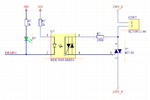bremenpl
Member level 3
Hello there,
I have a problem Im not sure how to resolve.
I need to build a device that will drive a heating element powered from 230V AC (50Hz). I will take feedback from analog temp sensors. That way I could implement some PID alghorithm to controll the temperature and keep it steady. If this would be DC voltage on the heater I would simply drive FETS using PWM from the microcontroller. The problem is this is AC and the PWM would have to be synchronised.
I have a circuit here that would work only for turning ON/OFF the Diacs controlling the heater. I am not sure how to sync my PWM signal with 50Hz AC frequency.

I would really aprichiate any help in this matter. I need to know how can I smoothly controll the temp this way. I believe light dimmers work simmilar way.
I have a problem Im not sure how to resolve.
I need to build a device that will drive a heating element powered from 230V AC (50Hz). I will take feedback from analog temp sensors. That way I could implement some PID alghorithm to controll the temperature and keep it steady. If this would be DC voltage on the heater I would simply drive FETS using PWM from the microcontroller. The problem is this is AC and the PWM would have to be synchronised.
I have a circuit here that would work only for turning ON/OFF the Diacs controlling the heater. I am not sure how to sync my PWM signal with 50Hz AC frequency.

I would really aprichiate any help in this matter. I need to know how can I smoothly controll the temp this way. I believe light dimmers work simmilar way.
